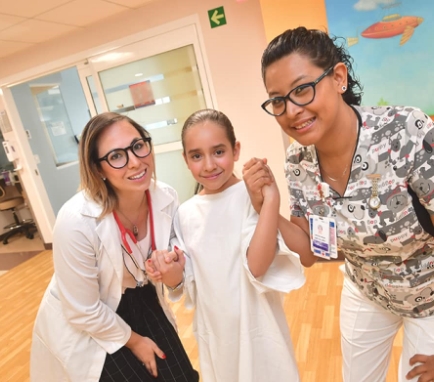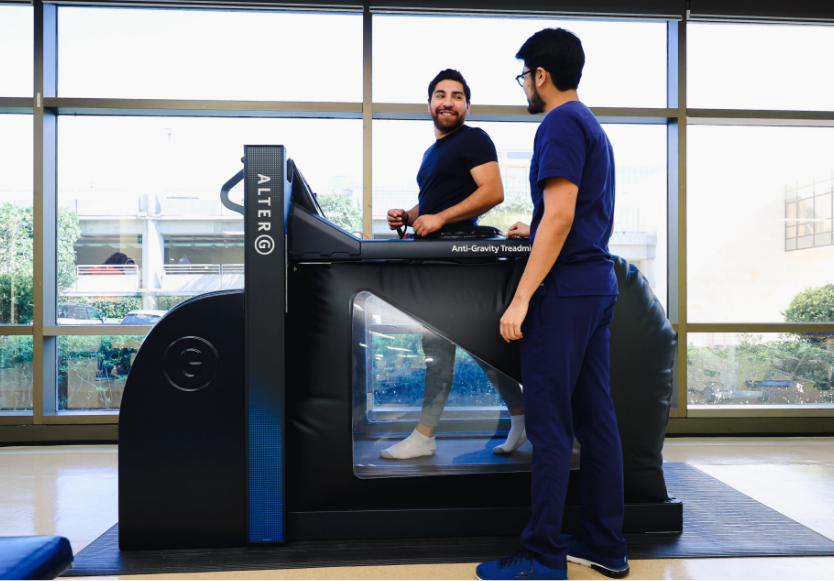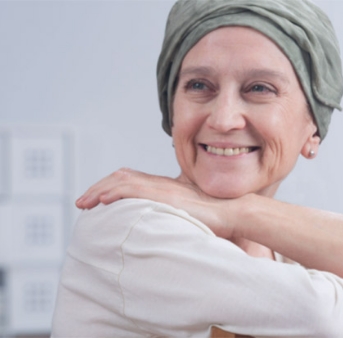Other Rehabilitation Programs
Pediatric
rehabilitation
At the ABC Medical Center we recommend pediatric rehabilitation with an early-stage prevention approach, an example is when there may be a neurological risk factor with the implementation of an environment modification program, stimulation and / or early intervention in the Unit of Neonatal Intensive Care can prevent the establishment of neurological sequelae.
Likewise, the detection of postural defects (flat foot, cavus foot, genu valgus and / or varus, scoliosis) and ligament hypermobility allows the development of programs in a timely manner to avoid structuring and permanent joint damage.

Pediatric
rehabilitation
There are several pathologies in the pediatric stage such as neuromuscular diseases (muscular dystrophy, myopathies), peripheral nerve diseases (congenital or acquired neuropathies), plexus lesions (traumatic, infectious or tumor plexopathies), motor neuron diseases (spinal muscular atrophies), spinal cord injury (spina bifida, myelomeningocele, meningocele, Arnold Chiari disease, traumatic spinal cord injury), cerebral palsy, dysmorphic syndromes, osteogenesis imperfecta, arthrogryposis, developmental dysplasia of the hip, among others, requiring rehabilitation from the establishment of the diagnosis so that the patient can maximize their potential and promote family, social and school integration.
Currently, the prevention approach in Rehabilitation intervenes in early stages, such as children with risk factors for neurological damage in which the implementation of an environment modification program, stimulation and/or early intervention in the Neonatal Intensive Care Unit avoids the establishment of neurological aftereffects. Likewise, the detection of postural defects (flat foot, pes cavus, genu valgum and/or varum, scoliosis) and ligament hypermobility allows the development of programs in a timely manner to avoid structuring and permanent joint damage.

Frequent pediatric conditions that require rehabilitation from the establishment of a diagnosis:
Frequent pediatric conditions that require rehabilitation from the establishment of a diagnosis:
- Neuromuscular diseases
- Peripheral nerve diseases
- Plexus injuries
- Motor neuron diseases
- Spinal cord injuries
- Arnold Chiar disease
- Traumatic spinal cord injury
- Child brain paralysis
- Dysmorphic syndromes
- Imperfect osteogenesis
- Arthrogryposis
- Developmental dysplasia of the hip
Neurological rehabilitation
The brain has the ability to resolve dysfunctions or damage through neuronal plasticity that allows rearrangement and recovery at the cellular level. Stimulating this process is essential to rehabilitate patients with damage to the central nervous system.

Patients can present a variety of diagnoses such as:
- Head injuries.
- Stroke.
- Spinal cord injury.
- Aneurysms.
- Parkinson's disease.
- Tumors of the central nervous system.
- Neurological diseases such as: multiple sclerosis, amyotrophic lateral sclerosis, Guillain Barre syndrome, neuropathies, polyneuropathies, etc.
Treatment goals are individualized, but most are aimed at:
- Improving control of patient movement.
- Improving coordination.
- Improving muscle strength.
- Encourage walking.
- Reduce spasticity, tremor, and fatigue.
- Cognitive therapy for behavioral management and higher mental functions.
- Reintegration to daily life activities and/or improve their quality of life, capacity, and autonomy.
- Guidance and education in patient management for the family and/or caregiver.
- Orientation in the needs of adaptations or accessories for the return home.
Contact a specialist
Geriatric rehabilitation
The average lifespan of the population has increased significantly in recent years, therefore, they need help to improve their quality of life, through the development of greater muscle strength, balance, coordination, improved posture and the way they walk; factors that will allow them to avoid falls, relieve chronic pain, expand their range of motion through physical exercise, and prevent fractures.
Cardiopulmonary rehabilitation
The purpose is to reduce the symptoms of patients with pulmonary and cardiac disease, improving their capacity and tolerance to exercise, increasing independence in daily life activities, it is intended to reduce the disability caused by heart and respiratory disease, improve these patients’ quality of life.
Cardiovascular rehabilitation
Its purpose is to improve the physiological and psychological state of the patient through treatments that include physical exercise and advice to reduce risks and change habits that allow adopting a healthy lifestyle.
Program objectives:
- Improve physical ability.
- Create habits for physical exercise.
- Improve the quality of life and independence.
- Prevent cardiovascular events.
- Modify risk factors:
- Control of body weight.
- Glycemic control.
- Control of blood pressure.
- Eradication of smoking.
- Reduction of stress, anxiety and depression.
Rehabilitation in plastic and reconstructive surgery
Its objective is to help in the recovery of plastic or reconstructive surgery patients in procedures such as augmentation or reduction mammoplasty, tummy tuck, liposuction, median nerve release (carpal tunnel syndrome), and tendinoplasty, among others; to counteract pain, inflammation, bruises, edema, scar tissue; through motor therapy and muscle strengthening.
Sports rehabilitation
Los deportistas, sean aficionados o de alto rendimiento, suelen sufrir lesiones con frecuencia, por lo que con un tratamiento individualizado y un plan de rehabilitación, es posible el retorno a sus actividades deportivas.
Las lesiones más comunes que atendemos en fisioterapia son golpes, elongaciones, distensiones y roturas de fibras musculares, tendinopatías, epicondilitis o codo de tenista, hombro doloroso y fascitis plantar.
Oncological rehabilitation
The objective of a comprehensive rehabilitation program in cancer patients is to help cancer patients adapt and achieve optimal functioning, minimizing the effects of cancer derived from the disease and/or its treatment such as chemotherapy, radiotherapy, immunotherapy, brachytherapy, offering the patient and the family support to improve the quality of life, achieved by evaluating the needs of the cancer patient from the detection, recovery process and for patients who conclude their cancer treatment.
Patients can have a variety of diagnoses including:
- Prostate Cancer.
- Lung Cancer.
- Breast Cancer.
- Brain and spinal cord tumors.
- Head and neck cancer.
- Leukemia.
- Lymphoma.
- Bladder Cancer.
- Anorectal cancer.
- Pancreatic Cancer.
Functional limitations that the cancer patient can present are:
- Peripheral neuropathy due to chemotherapy.
- Lymphedema.
- Low back pain from metastasis, cancer, or from cancer treatment.
- Joint pain in arm or leg due to metastasis, cancer or derived from cancer treatment.
- Shoulder or neck pain.
- Deconditioning due to weakness or fatigue.
- Nervous dysfunction.
- Cognitive impairment.
- Impaired swallowing.
- Language alteration.
- Difficulty opening the mouth (trismus)
- Altered balance and gait.
- Bladder or bowel incontinence
- Sexual dysfunction.
Rehabilitation in the Intensive Care Unit
With medicine advances, the survival of critically ill patients has improved. The design of an early mobilization program begins when the patient is physiologically stable and includes progressive therapeutic activities. The rehabilitation program does not end when the patient is discharged from hospital, but until the patient re-enters its family and work environment independently.
Rheumatological rehabilitation
Rheumatic diseases such as arthritis, ankylosing spondylitis, osteoarthritis, and vasculitis, among others, are of a chronic-degenerative type that affect the patient more seriously over time. Rehabilitation, which is a complement to pharmacological treatment, seeks to reduce pain and inflammation, improve mobility and joint stiffness, in addition to strengthening muscle mass, delaying the degenerative process.
Orthopedic rehabilitation
It is focused on providing comprehensive management for the preservation and functional recovery through the evaluation, prevention, treatment, and rehabilitation of an injury to the musculoskeletal system.
Within the treatment, modifications in the lifestyle that allow a better state of health are suggested.
Conditions we treat:
- Knee injuries (anterior cruciate ligament, meniscopathies, runner’s knee, iliotibial band syndrome, knee sprains, pre and post-surgical management of total knee replacement, among others).
- Shoulder injuries (rotator cuff injuries, glenoid labrum injuries, glenohumeral instability, tendinitis, subacromial impingement, pre and postsurgical management).
- Elbow injuries (epicondylitis – golfer’s and tennis elbow, sprains, bursitis, tendonitis).
- Ankle and foot injuries (sprains, impingements, tendonitis, plantar fasciitis, Morton’s neuroma, osteochondrosis, postsurgical bill management).
Hip injuries (hip impingement, coxarthrosis, tendinitis, postoperative rehabilitation of hip arthroplasty). - Hip injuries (hip impingement, coxarthrosis, tendinitis, postoperative rehabilitation of hip arthroplasty).
- Cervical and lumbar spine injuries (cervical pain, low back pain, sprains, spondylolisthesis, spondylosis, scoliosis, narrow cervical or lumbar canal, radiculopathies, cervical root pain, sciatica, thoracic outlet syndrome, sacroiliitis).
- Pre and post-surgical management of musculoskeletal injuries.
Rehabilitation in amputees
Our treatment ranges from the post-operation stage, before the use of prostheses and once it begins to be used.
Its objective is to help the patient to adapt physically and emotionally to the new situation, maximizing their functional independence to achieve their integration into social and work life.
Our rehabilitation team will provide support for you to learn how to care for the wound, manage pain, adjust and use the prosthesis.
Contact a specialist
Our Locations
At ABC Medical Center, we are prepared to serve you in out two Campuses 24/24h, 7 days a week.
Campus Observatorio
Sur 136 No. 116, Col. Las Américas,
Álvaro Obregón, 01120, Cd. de México.
Tel. 55 5230 8000
Campus Santa Fe
Av. Carlos Graef Fernández 154, Col. Santa Fe,
Cuajimalpa, 05300, Cd. de México.
Tel. 55 1103 1600



